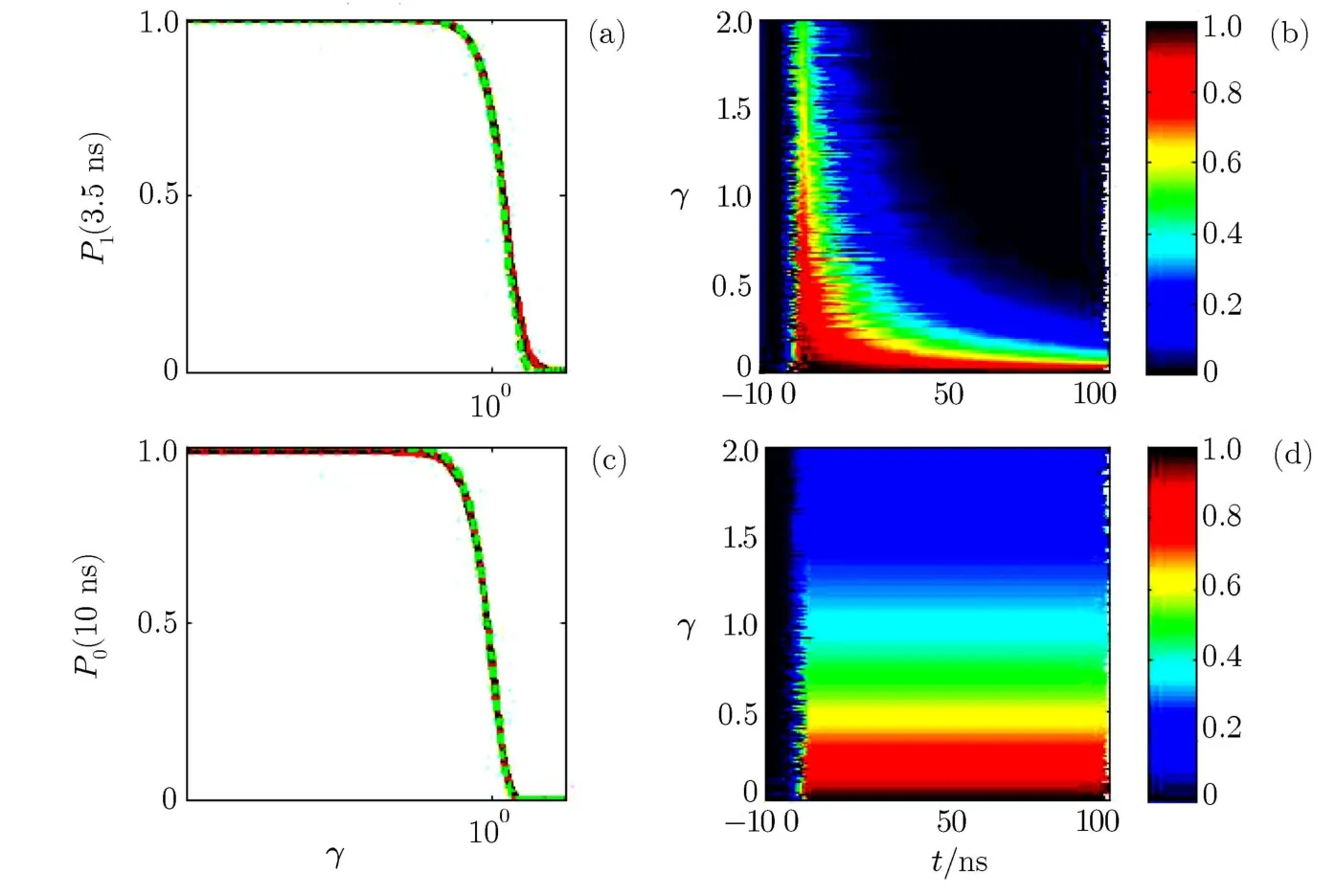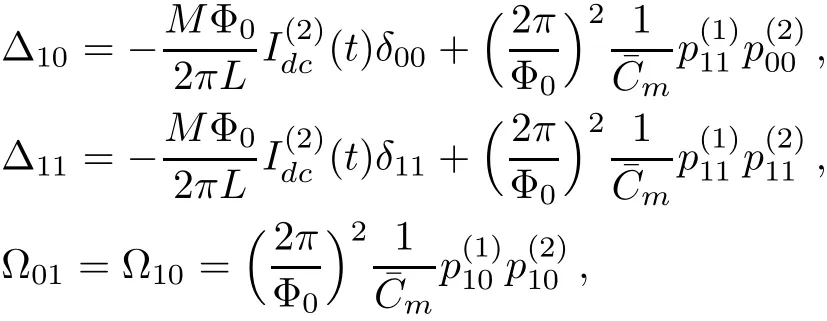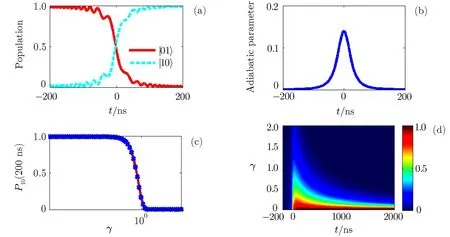Stark-Chirped Rapid Adiabatic Passage in Presence of Dissipation for Quantum Computation∗
SHI Xuan(石轩),C.H.Oh, and WEI Lian-Fu(韦联福),3,‡
1Quantum Optoelectronics Laboratory,School of Physics and Technology,Southwest Jiaotong University,Chengdu 610031,China
2Centre for Quantum Technologies and Department of Physics,National University of Singapore,3 Science Drive 2,Singapore 117542,Singapore
3State Key Laboratory of Optoelectronic Materials and Technologies,School of Physics Science and Engineering,Sun Yet-sen University,Guangzhou 510275,China
1 Introduction
Over recent years,quantum computation has attracted much attention partly because the discovery of quantum algorithm for specif i c problems provides a tremendous speedup in computation,compared to a classical computer.[1−2]A critical prerequisite for building a quantum computer is to perform the basic single-and twoqubit gates with high f i delity above certain threshold levels.[3−4]
A typical ingredient in quantum computing is the coherent transfers of the population between the qubit states. Basically,there are two approaches to realize the population transfers between two selected quantum states;one makes use of the Rabi oscillations and the other is based on population passages.[5−7]For Rabi oscillations,the transfer eきciency is strongly dependent on the precisely-designed duration of the applied pulse.On the other hand,the logic gates implemented via population passage techniques,such as shortcut to adiabatic passage,[8]the stimulated Raman adiabatic passage(STIRAP)[9]and the Stark-chirped rapid adiabatic passage(SCRAP),[10]are evolution-time insensitive and thus robust against the imperfections of durations of the applied pulses.Until now,most of population passage schemes to implement the quantum computation are based on the pure quantum systems,but their practicallyexisting dissipative eあects(e.g.,spontaneous emissions,phase relaxations,and the outsides from the system)have not been exactly treated.The f i delities of the logic gates for the realistic quantum computing demonstrations are particularly important,therefore,it is necessary to investigate how the practically-existing dissipation inf l uences on the eきciencies of the population passages and consequently the f i delities of the relevant logic gates for quantum computing.
Usually,the dynamics of an open quantum system can be described by two approaches:[11]the master equation for the reduced density matrix and the Heisenberg–Langevin equation by introducing environment noise operators.Additionally,a relatively-simple approach,i.e.,dissipative Schr¨odinger equation with a non-Hermitian Hamiltonian describing the damping,is also utilized.In this approach the environment eあects are considered simply by phenomenologically introducing certain non-Hermitian terms in the Hamiltonian of the system.Then,the dynamics of the treated open system can still be de-scribed by the usual Schr¨odinger equation.Indeed,this idea has been utilized to investigate the dissipative effects in the well-known STIRAP for three-state Λ atomic systems,[12]wherein the decay rate Υ of the intermediate state|2〉is served as the main source of the dissipation during the population transfers from the state|1〉to the target state|3〉.The damping of the transfer eきciency with Υ shows diあerent behaviors,i.e.,exponential at small Υ and polynomial at large Υ.This feature provides a realistic STIRAP scheme for three-state Λ atomic systems in the presence of decay of the intermediate state.For the present two-state system,the decay of the excited state is the dominant dissipative source,which mainly decreases the transfer eきciency of the SCRAP.[13]In this brief report,we examine how this dissipation inf l uences the f idelity of the SCRAP-based logic gates.For the simplicity,we treat the dissipation related to the excited state of the qubit by adding an imaginary part to the relevant diagonal term of the non-dissipative Hamiltonian.Our proposal is demonstrated specif i cally with the f l ux-biased Josephson qubits,but can also be applied to the other driven solid-state qubit systems.
2 Def i nition of the Model
Without loss of the generality,we assume that the twostate system is well prepared initially,at time t0=−∞,in the ground state|0〉.Our end is to maximize the f i nal population P1(∞)of the target state|1〉in the presence of the decay of|1〉.Originally,without dissipation of the twostate system the desired transfer can be precisely implemented by means of the standard SCRAP.[14−16]However,due to various practically-existing noises,such a transfer should be inf l uenced.
As a simplif i ed model the state decay of a quantum system can be generically described by adding a loss rate Γ(> 0)to its non-lossy Hamiltonian,as a negative imaginary part to the corresponding diagonal term. As a consequence,the time evolution of the probability amplitudes for the dissipative driven two-level system can be expressed by the equation[17]

Here,Ω(t)is the Rabi frequency coupling the levels of the two-state system,Δ(t)is relative to the pulse chirping the excited level and C0(t)and C1(t)are the probability amplitudes related to the states|0〉and|1〉,respectively.
To analyze the progress of SCRAP in the presence of state decay,we de fi ne the adiabatic states|+〉=sinθ(t)|0〉+cosθ(t)|1〉and|−〉=cosθ(t)|0〉− sinθ(t)|1〉,which are the instantaneous eigenstates of the Hamiltonian in Eq.(1)with Γ =0.Here,the mixing angle θ(t)is de fi ned as θ(t)=arctan[Ω(t)/Δ(t)]/2.In the basis defi ned by the adiabatic vectors|+〉and|−〉,Eq.(1)can be written as

Obviously,the oあ-diagonal elements in Eq.(2)result in the coupling between two adiabatic states|+〉and|−〉(i.e.,the passage paths for the desired population transfers).For the ideal case without state decay,i.e.,Γ=0,the desired adiabatic transfer can be implemented by properly designing the applied pulses to satisfy the condition:˙θ=0,i.e.,the adiabatic condition[18−19]

However,the second term in Eq.(2)shows that the damping of SCRAP corresponds to two ways,one is the decay of the adiabatic passage paths described by the diagonal elements and the other is the transition damping described by the nonzero oあ-diagonal elements.
For a counterintuitive pulse sequence with initial state|0〉(at time t= −∞,θ=0,then θ= π/2 at t= ∞),the transfer progress(which transfers the population from state|0〉to state|1〉)goes along the adiabatic path|−〉with the decay rate Γsin2θ.Along this adiabatic passage,the f i nal population of state|1〉is

while if the system is initially prepared at the state|1〉,then the population is transferred along the adiabatic passage|+〉(with the decay rate Γcos2θ)to the ground state|0〉.The f i nal population of the state|0〉reads

Absolutely,the non-adiabatic transition between the states|−〉and|+〉may also lead to the losses of P1ciand P0ci.As the dissipation is irreversible,the population transfer may be signi fi cantly destroyed by the strong dissipation.
3 Quantum Logic Gates in the Presence of Dissipation
In what follows,we investigate specif i cally how the dissipation of system inf l uences the f i delity of the SCRAP-based quantum logic gates.Our discussion is based on the SCRAPs in f l ux-biased Josephson qubits,but can be easily generalized to other physical systems.For operational simplicity,here linear Stark pulses,rather than the previous gaussian Stark pulses,[19]are applied to the qubits.
The quantum behavior of a f l ux-biased Josephson junction has been described in detail elsewhere.[20−21]The Hamiltonian of the system is

Here,the pump pulse Iac= ξ(t)cos(ω10t)is used to couple the qubit states and the Stark pulse Idcis applied to chirp the qubit’s transition frequency ω10.Also,Φ0=h/2e is the f l ux quantum,EJ=I0Φ0/2π is the Josephson energy,and λ =2πI0L/Φ0,m=CJ[Φ0/(2π)]2,φb0=2πIφ0M/Φ0.Consequently,the Hamiltonian of the driven qubit(with decay rate Γ)in the interaction picture can be expressed as

where δij= 〈i|δ|j〉,i,j=0,1, κ = ξ(t)/2,and Δ1(t)=MIdc(t)(δ11− δ00)/L.

Fig.1 (Color online)The population transfer without dissipation for implementing the single-qubit gate with a f l uxbiased Josephson junction.In(a)the two pulses are designed with a linear forms Idc(t)=0.1t A and ξ(t)= −1.88 nA(−3.5 ns ≤ t ≤ 3.5 ns,else where ξ(t)=0 V/m).With this pulse sequence,the population of the system initially prepared in the state|0〉completely transfers to the state|1〉.The corresponding adiabatic parameter is shown in(b).
When Γ=0,i.e.,for the ideal system without dissipation,we show in Fig.1(a)that the single-qubit gate,i.e.,the qubit inversions,can be realized by using a linear pump pulse Iacand a Stark pulse Idcto implement the desirable population transfer between the qubit states.It is shown that,under the counterintuitive pulse sequence(the applied Stark pulse Idcprecedes the pump pulse but turns oあf i rst),the qubit inversion is realized along the adiabatic passage|−〉(with 100%probability).Figure 1(b)exhibits that the adiabatic parameter η is fairly smaller than 1.This implies that the above progress for population transfers is really conf i ned in the adiabatic region.Unlike the Gaussian pulse used to control the population transfer,[19]the maximum value of the adiabatic parameter reaches 120,thus it is not the adiabatic progress.Note that the desired population inversions are f i nished within a relatively-short time interval,i.e.,τ1=20 ns,which is really rapid compared to the typical decoherence time(e.g.,0.3µs[22]).
Now,let us consider how the dissipation of the system inf l uences the above qubit inversions.The decay rate Γ is meaningless unless it is related to a real physical variation,such as the characteristic width of the driving pulses T.For the convenience,we introduce a dimensionless decay rate γ = ΓT[12]to illustrate the dissipation of our model.Then,the dissipation of the system can be divided into three regions;(i)weak dissipation(γ ≪ 1),(ii)strong dissipation(γ ∼ 1)and(iii)very strong dissipation(γ ≫ 1).In Fig.2 we show how the population probability of the target state varies with the decay rate γ and the evolution time t for the applied counterintuitive sequence pulses.Specif i cally,Figs.2(a)and 2(b)illustrate the population passage from the initial state|0〉to the target state|1〉along the adiabatic passage|−〉;while Figs.2(c)and 2(d)are relative to the population transfer from the state|1〉to the state|0〉along the adiabatic passage|+〉.The time-dependent population probabilities of the target state are calculated by Eqs.(4),(5).As a comparison,we also provide the relevant results by directly solving the Schr¨odinger equation with Hamiltonian(7).Here,we assume the qubit is in the initial state at time t0=−10 ns,the passage transfer is f i nished at time tf=10 ns,and the system is in the superposition state during the time tb=−3.5 ns to tm=3.5 ns.It is shown that the adiabatic approximation made for delivering Eqs.(4)and(5)works well.The above numerical results show clearly that:(i)in the weak dissipation region,i.e.,γ≪1,the dissipation can be really neglected,and the eきciency of the population transfer is suきciently high(almost 100%);in the strong dissipation,i.e.,γ∼1,the population eきciency is lower than 1;the f i nal population may be completely destroyed with a very strong dissipation γ ≫ 1.(ii)For the population passage from the state|0〉to the state|1〉,the transfer probability de-creases as an exponential function exp[−2Γ(t− tm)]after the passage region t>tm;while,for the passage from the state|1〉to the state|0〉,the loss of the population can still be described by an exponential function exp[−2Γ(t− tb)]before the passage region t<tb.(iii)The non-adiabatic transition weakly inf l uences the population transfer,and the dissipation of the system is mainly from the decay of the adiabatic passage paths.

Fig.2 (Color online)Population transfer with diあerent decay rate for single-qubit gate.The pulses used to implement the adiabatic passage are the same linear pulses with the counterintuitive sequence for single-qubit gate discussed without dissipation.The population probability with initial state|0〉at time t0= −10 ns varies with γ = ΓT(T=2× 10−8)described by(a),while(c)is relative to the initial state|1〉.The red lines both in(a)and(c)are obtained by numerical solution of the Shr¨odinger equation related to Eq.(7),and the dashed green line in(a)and(c)is the analytical results from Eq.(4)and Eq.(5)respectively.Finally,(b)and(d)give the dynamics of the population marked with diあerent colors for the varied γ and the evolution time t with initial state|0〉and|1〉,respectively.
To be more thorough,we investigate how the dissipation inf l uences the SCRAP-based two-qubit gate with two capacitively-coupled f l ux-biased Josephson qubits. For the simplicity,here the two junctions are assumed to be identical and thus two qubits possess the same energy structure.Originally,the two-qubit gate can be implemented also by the adiabatic population passages[10]via applying a controllable dc current I(2)dcto chirp the second qubit.Considering the practically-existing decay of the excited state of the qubits(with the same decay rate Γ for simplicity),the Hamiltonian of such a driven two-qubit system can be simply expressed as

with


whereC¯m=CJ(1+ζ)/ζ(ζ is the eあective coupling coeffi cient)represents the interaction between two qubits and

Still,one can easily check that the populations of|00〉and|11〉of the present two-qubit system are always unchanged,and the population transfer only occurs between the states|01〉and|10〉.So the dynamics of the two qubits can be limited to a 2×2 subspace generated by the states|01〉and|10〉.In absence of the dissipation,i.e.,Γ =0,Figure 3(a)shows that the population transfer can be easily achieved between the states|01〉and|10〉.Figure 3(b)displays that the maximum value of the adiabatic parameter η during such a passage is about 0.14.Thus,the usual i-SWAP gate has been realized by the adiabatic SCRAP technique.
In Figs.3(c)we investigate how the dissipation inf l uences the population transfer from the state|01〉to|10〉for a def i ned passage time interval τ2=400 ns.It is shown that results by numerically solving the Schr¨odinger equation with the Hamiltonian(8),and those by analytically solving the evolution within the subspace with the reduced Hamiltonian(def i ned by the adiabatic vectors|+〉and|−〉)

with

are consistent.Obviously,the dissipation of the two-qubit operation is not relative to the non-adiabatic transition between the two passage paths|+〉and|−〉.Moreover,the dissipation of the SCRAP-based two-qubit gate can be also divided into three regions.The eきciency of the population transfer is suきciently high in the weak dissipation region γ ≪ 1,but it is decreasing when the system is in the strong(γ ∼ 1)and very strong dissipation(γ ≫ 1)regions.In Fig.3(d)we depict how the transfer probability depends on the dissipation parameter γ and the evolution time t.We can see from the f i gure that,for the suきciently-weak dissipation(typically for γ < 0.1)the passage time could be set as a suきciently-long interval,e.g.,2µs(if it is still shorter than the decoherence time of the system).However,for the strong dissipations,γ∼1 and γ ≫ 1,the population transfer should be achieved within suきciently-short time interval.

Fig.3 (Color online)Population transfer for the two-qubit gate with a Stark pulse Id(2c)=−3.5t.(a)population transfers between the two-qubit states|01〉and|10〉,and(b)the corresponding adiabatic parameter during the passages.(c)The fi nal population of the state|10〉at a de fi ned time t=200 ns varies with the dissipation γ = ΓT(with T=4 × 10−7).The red line in(c)is obtained by numerical solution to the Schr¨odinger equation related to the Hamiltonian(8)and the dotted blue line is the analytic solution to the dynamics for the reduced Hamiltonian(9).(d)Probability of transfer from the states|01〉to|10〉varies with the dissipation parameter γ and the evolution time t.Colorbar implies the variation of probability.
4 Conclusion
In summary we have investigated the Stark-chirped rapid adiabatic passage(SCRAP)of a driven dissipative two-level system.As a simplif i ed model,we describe the dissipation of the system by adding a phenomenal parameter Γ to the chirped excited state of the system.Then,by solving the relevant Schr¨odinger equation we then discuss how the practically-existing dissipation inf l uences the population transfer between the two selected levels of the system.We have found that the desired SCRAP probability is related to the eあective dissipative parameter γ = ΓT(with T being the time interval of population passage),and consequently we can divide the dissipation into three regions;(i)weak dissipation(γ ≪ 1),(ii)strong dissipation(γ ∼ 1)and(iii)very strong dissipation(γ ≫ 1).In the weak dissipation region(γ ≪ 1),the interaction between the quantum system and the environment is really small,thus the inf l uence from the environment is suき-ciently weak.As a consequence,the population transfer from the initial state to the target state can be robustly implemented.As the interaction between the quantum system and the environment increases(γ ∼ 1),the leakage of the quantum system increases,such that the population probability is decreasing.When the coupling between the quantum system and environment is very strong(γ ≫ 1),the situation is more complex:(i)If the qubit is initially prepared at its ground state,the eあect of the large decay rate makes the quantum system decouple from the control-ling pulses(pump pulse and Stark pulse),then the qubit will not be excited to its excited state and is still in its initial ground state;(ii)If the qubit is initially prepared at the excited state,the relevant population will decay quickly to the environment and the system could not be excited again.Our numerical results clearly show that,in the weak dissipation regime,the SCRAP-based quantum computing scheme still works well;while in the strong dissipation regime the f i delity of quantum gate implemented by the SCRAP technique decreases manifestly.Certainly,if the system works in the very strong dissipation regime,then the SCRAP technique can not be utilized to implement quantum computing.
Our generic discussion has been demonstrated with a typical quantum computing system,i.e.,the f l ux-biased Josephson qubits.In this specif i c model we have found that the loss of the transfer eきciency of the SCRAP is related to both the non-adiabatic transitions between the adiabatic passage paths and the decay of the adiabatic passage paths.During the passage for implementing the single-qubit gate,we f i nd that the loss owing to dissipation-induced transition between two adiabatic passage paths is really small and thus negligible.For the twoqubit gate,we f i nd that the dissipation-induced transition between two adiabatic passage paths vanish,and only the decay of the adiabatic passage paths exists.Based on this analysis we have delivered a proper approach to implement the quantum logic gates in such a system in the presence of dissipation.Our results provide quantitative estimates of the population losses during the SCRAPs,and thus should be useful for the realistic qubit operations.
[1]P.W.Shor,Proceedings of the 35th Annual Symposium on Foundations of Computer Science,IEEE Computer Press,Los Alamitos(1994)124.
[2]L.K.Grover,Phys.Rev.Lett.79(1997)325.
[3]Jerry M.Chow,Jay M.Gambetta,A.D.C´orcoles,et al.,Phys.Rev.Lett.109(2012)060501.
[4]Norbert Schuch and Jens Siewert,Phys.Rev.A 67(2003)032301.
[5]M.Fleischhauer,R.Unanyan,B.W.Shore,and K.Bergmann,Phys.Rev.A 52(1995)R2493.
[6]B.W.Shore,K.Bergmann,A.Kuhn,S.Schiemann,and J.Oreg,Phys.Rev.A 45(1992)5297.
[7]Mei Lu,Yan Xia,Jie Song,and He-Shan Song,J.Phys.B:At.Mol.Opt.Phys.46(2013)015502.
[8]MeiLu,Li-Tuo Shen,Yan Xia,and JieSong,arXiv:1305.5458(2013).
[9]K.Bergmann,H.Theuer,and B.W.Shore,Rev.Mod.Phys.70(1998)1003.
[10]L.F.Wei,J.R.Johansson,L.X.Cen,S.Ashhab,and Franco Nori,Phys.Rev.Lett.100(2008)113601.
[11]Marlan O.Scully and M.Suhail Zubairy,Quantum Optics,Cambridge University Press,Cambridge(1997).
[12]N.V.Vitanov and S.Stenholm,Phys.Rev.A 56(1997)1463.
[13]G.Dridi,S.Gu´erin,H.R.Jauslin,D.Viennot,and G.Jolicard,Phys.Rev.A 82(2010)022109.
[14]T.Rickes,L.P.Yatsenko,S.Steuerwald,T.Hlfmann,B.W.Shore,N.V.Vitanov,and K.Bergmann,J.Chem.Phys.113(2000)534.
[15]A.A.Rangelov,N.V.Vitanov,L.P.Yatsenko,B.W.Shore,T.Halfmann,and K.Bergmann,Phys.Rev.A 72(2005)053403.
[16]L.P.Yatsenko,N.V.Vitanov,B.W.Shore,T.Rickes,and K.Bergmann,Opt.Commun.204(2002)413.
[17]N.V.Vitanov and S.Stenholm,Phys.Rev.A 55(1997)2982.
[18]X.Shi,M.Zhang,and L.F.Wei,Phys.Rev.A 84(2011)062310.
[19]W.Nie,J.S.Huang,X.Shi,and L.F.Wei,Phys.Rev.A 82(2010)032319.
[20]J.Clarke,A.N.Cleland,M.H.Devoret,D.Esteve,and J.M.Martinis,Science 239(1988)992.
[21]J.M.Martinis,M.H.Devoret,and J.Clarke,Phys.Rev.B 35(1987)4682.
[22]J.Clarke and F.K.Wilhelm,Nature(London)453(2008)1031.
 Communications in Theoretical Physics2014年2期
Communications in Theoretical Physics2014年2期
- Communications in Theoretical Physics的其它文章
- Solutions of the Schr¨odinger Equation with Quantum Mechanical Gravitational Potential Plus Harmonic Oscillator Potential
- Exact Polynomial Solutions of Schr¨odinger Equation with Various Hyperbolic Potentials∗
- ONEOptimal:A Maple Package for Generating One-Dimensional Optimal System of Finite Dimensional Lie Algebra∗
- Dynamics of Light in Teleparallel Bianchi-Type I Universe
- Entangled Three Qutrit Coherent States and Localizable Entanglement
- Robust Quantum Computing in Decoherence-Free Subspaces with Double-Dot Spin Qubits∗
